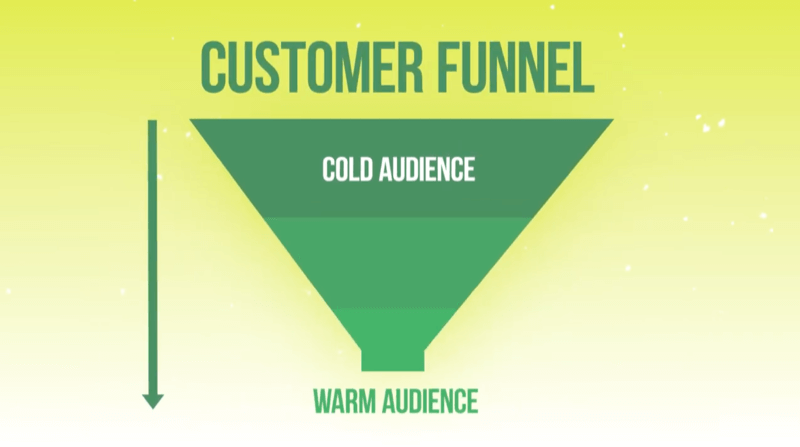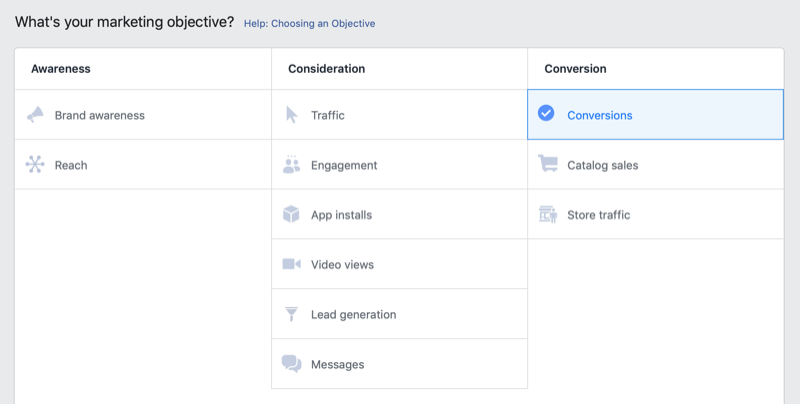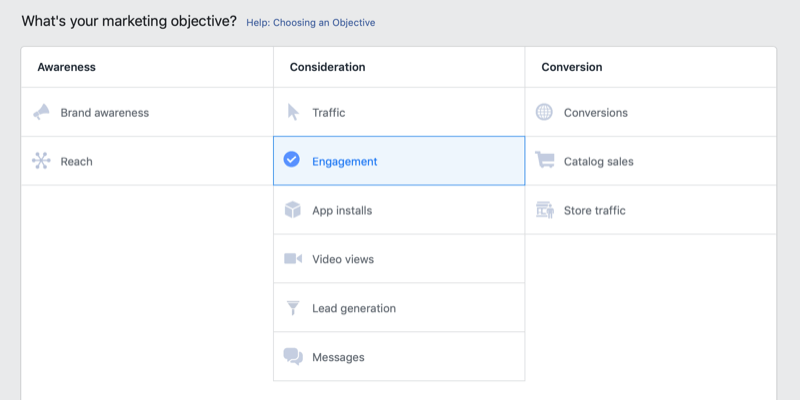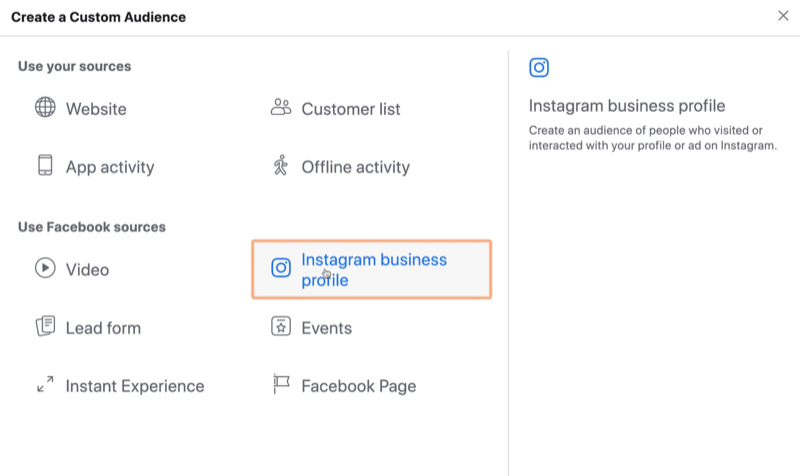Wondering how to build an effective ads funnel on Instagram? Looking for tips to choose the right objectives or targeting audiences?
In this article, you’ll find four ways to optimize your Instagram ads funnel for different stages of the customer journey.

To learn how to improve your Instagram ads funnel, read the article below for an easy-to-follow walkthrough or watch this video:
Note: This article assumes you know how to set up an Instagram ad campaign. Watch this video for step-by-step instructions to get started advertising on Instagram for just $5 per day.
#1: Design Your Customer Funnel Around Instagram User Behavior
When you hear the word remarketing, what comes to mind? Continuing to talk to people who have visited your company’s website, most likely. But if you’re an Instagram user, you just want to hang out on the platform and don’t really want to go to websites.
While these two behaviors might seem incompatible, you can do funnel building that leverages the power of keeping people on the Instagram platform while also being able to remarket to them in the future.
One of the most valuable uses of your Instagram ad money, other than sales, is reaching out to your target audience. Too many times, I see brands that spend money and say, “Oh, those are the sales we got. It’s all over.”
The thing is, it’s not all over. You also reached a bunch of people who might want to buy but just not when they saw the ad. You want to make sure that the money you’re spending to reach these people continues to be put to good use as they move down the customer journey and you build that customer funnel.
When we talk about a customer funnel, it’s important to envision it like one. You have the top of the funnel, which is usually called your cold audience. These are people who have never visited your website or don’t know anything about your brand.

Then they progressively learn more about your products and services to the point where they’re considered bottom of the funnel, which means they’re very likely to buy.
This whole process is called the customer funnel.
When you create Instagram ads, the first thing you do is select a campaign objective. Most of the time, advertisers want to convert people.

This makes sense in theory. However, if you target a top-of-funnel audience that doesn’t know your brand well and tell Facebook, “I want you to turn these people into paying customers,” it’s going to be competitive and there aren’t a lot of those people. It’ll be expensive to reach them and they’re not worth that much money to you yet because their likelihood of buying is very low.
Think about yourself as a user. When was the last time you saw an ad on Instagram and thought, “I’m going buy that right now”? You know nothing about the brand and have never interacted with anything they’ve put out. You’re not likely to just click on the ad, go to the website, and buy a product for $100. You want to learn more about the brand and understand what they’re selling, how much it costs, and what you get. That’s hard to convey with one ad.
With an Instagram ads funnel, where there are multiple steps involved, you need to be aware of your total costs for these types of efforts. Look at the total amount of money you’re spending and what you’re getting out of it. It’s not really fair to look at an engagement campaign and say, “This isn’t converting, it’s not creating customers, so I’m just going to turn it off.” That’s not its job. Its job is to get interactions and fill the top of the funnel. The job of the bottom of the funnel is to convert them.
So no matter how you divide the money up between those two things, look at it as one spend. You’re using campaigns to create an ecosystem of people who come into your funnel and exit as happy customers. If you evaluate it as a broken-up budget across a bunch of different campaigns, you’ll wind up spending a lot of money on the bottom of the funnel and never really fill the top.
#2: Choose the Engagement Objective for Top-of-Funnel Instagram Ads
Now that you know why conversion ad types are so expensive, let’s talk about some ways to get to that core audience for a lot less money. When you set up your Instagram campaigns, instead of choosing Conversion as the objective, choose something that has a cheaper cost.
My favorite way to do that is to choose engagement. Engagement audiences are much easier for Instagram to grow, scale, and define. You’re not asking Instagram to find people who’ll leave the platform, let alone buy as soon as they see your ad. Engagement ads are a low-cost way for Instagram to find people who are interested in your brand.

If you run engagement ads on Instagram, it’s important to understand what your audience responds to. You’ll probably find that the content people engage with on Instagram is different from what they engage with on Facebook. Instagram is a much more visual medium. The body copy isn’t called out as much and there aren’t any headlines. The way you tell your story and encourage people to interact is probably different, too.
You also need to be familiar with how different placements work. Instagram story ads operate very differently than feed ads and the nuances are not small. Understanding what those different ad experiences look like will help you design highly engaging top-of-funnel creative to get as large an audience as possible engaging with your Instagram ads.
#3: Choose the Traffic or Lead Generation Objective for Middle-of-Funnel Instagram Ads
We’ve talked about top of the funnel and bottom of the funnel. So maybe you’re wondering, “Is there a middle of the funnel?” In fact, there is.
The middle of the funnel is interesting for brands, though. Sometimes it’s very much needed and other times it’s not. Your data will help you decide whether it’s something you need to consider spending time on.
Say you’re spending money on the top of the funnel and you’re getting people interested in your brand and then remarketing to them, assuming they’re bottom of the funnel. You’re pushing for a conversion that they’re just not doing. That’s probably where you need a middle of the funnel.
Get Instagram Marketing Training – Online!

Want to improve your engagement and sales with Instagram? Then join the largest and best gathering of Instagram marketing experts as they share their proven strategies. You’ll receive step-by-step live instruction focused on organic Instagram marketing, content creation, and Instagram ads. Become the Instagram marketing hero for your company and clients as you implement strategies that get proven results. This is a live online training event from your friends at Social Media Examiner.
Something isn’t connecting with them. Maybe it’s perceived value versus cost. Maybe they don’t understand enough about your product or service. You can still address that in the funnel and with remarketing. This audience isn’t totally cold but it’s not valuable to you yet. It’s also not the high-value people at the bottom of the funnel that you want to pay a lot of money for.
You may want to pick campaign objectives that are somewhere in the middle. To illustrate, you could go with the Traffic objective and run blog posts to these people. Choose your most visited, longest, or most informative blog posts.

Or you could run an Instagram lead ad where you say, “Here is our 50-page eBook on how to do this.”

Anything that continues to add value but doesn’t feel like the commitment of a purchase is perfect for the middle of the funnel. You want to nurture these people until they’re ready to raise their hand and be at the bottom of your funnel.
#4: Capitalize on Engagement Audiences for Instagram Funnel Retargeting
I see too many businesses spend money on Instagram ads and not maximize their audience. Let’s talk about a way to make sure you’re doing that even when you’re buying cheaper audiences at the top of the funnel.
Let’s say your campaign objective is to get people to engage with your Instagram ad. You’ll get those engagements but people do other things with those ads than just engage with them.
If your Instagram ad contains video, for instance, you can create audiences based on what video people watched and how long they watched it. Those people might be different from those who engaged with the ad so you’re getting a second audience of engagers to remarket to without spending any more money.
There are many ways you can create these kinds of combinations. The key is to look at all of the options Facebook and Instagram give you to create those audiences without having to set up separate buys to get the data.
To create an Instagram engagement audience, open Facebook Ads Manager and navigate to Audiences. Then click Create Audience and select Custom Audience from the drop-down menu.

In the Create a Custom Audience window, select Instagram Business Profile as the source.

Now pick how this audience engaged with you on Instagram. The default setting is everyone who engaged with your business on Instagram. But you can get more specific and choose people who engaged with a post or ad, visited your business profile, sent you a message, or saved a post or ad.

You can also decide how far in the past you want to go. The default is 30 days but if you don’t have a ton of website visitors, you can go back further (up to a year) to make the pool bigger. If you want to make the audience larger, you might create a couple of different segments of varying date lengths and save them as separate audiences to see which one works best for you.
If you want to create a video view audience, start with the same steps as above but this time, select Video as the source.

There are predetermined lengths of time you can choose from to segment your audience: 3, 10, or 15 seconds. Or you can do it by percentage. If your video is longer, say 15 minutes, you may want to choose people who have watched 25% of your video.

Next, pick which video you want to focus on. If you don’t have a lot of views per video and the videos are generally targeting the same people, you can choose multiple videos to ensure the audience is big enough to remarket. You’re showing your ads to people who don’t know you and they’re showing they’re interested either by watching your video or engaging.

So now people are moving through that customer funnel and they’re on your brand journey. As they get closer to the bottom of the funnel, they’re worth more to you. That’s where those Conversion objective prices start to make more sense.
It may be that they’re at the point where you can get them to sign up for your email list but they’re not ready to purchase. You might have to experiment with different types of conversions to figure out what’s going to work. But I guarantee your conversion rate and costs will be a lot lower than trying to push that at the top of the funnel.
Pro Tip: When you’re setting up your Instagram ad sets, think through not only who you’re trying to reach but also who you’ve already reached or simply don’t want to reach. You might want to consider people who visited your website but only viewed one page, or people who’ve already converted. You don’t want to spend money showing them top-of-funnel ads when they’re already happy customers.
Conclusion
These four tactics will help you build a more effective ads funnel on Instagram. Start by designing your customer funnel around Instagram user behavior. Also make sure you choose the right campaign objectives for your top- and middle-of-funnel Instagram ads. Finally, capitalize on engagement audiences for Instagram funnel retargeting.
What do you think? How will you optimize your Instagram ads funnel for different stages of the customer journey? Share your thoughts in the comments below.

